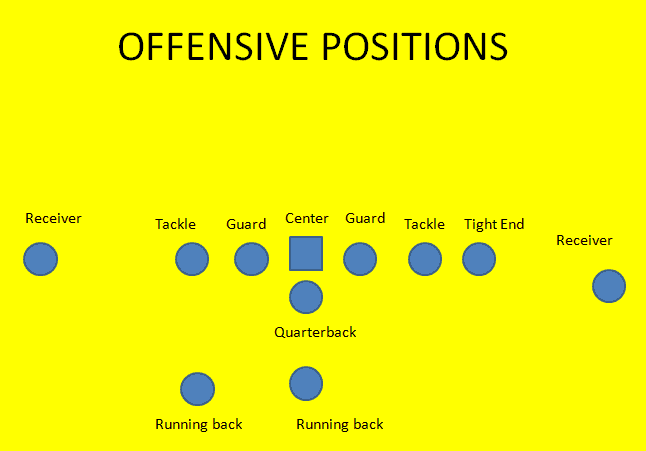Football is one of America’s most popular games. There is a lot of passion and desire around the game of football. The fall season brings a sense of excitement for those interested in the game of football.
Football can be one of the most confusing games if you are trying to learn how it works. Our youth in America begin playing around the age of seven. The game of football continues from youth to middle school to high school, to the college level, and finally to the professional level.
Whether you are seeking some knowledge or are interested in becoming better at football, or maybe you have been assigned the task of coaching a football team, we are here to help.
There are 11 positions on offense. All 11 have a task and if completed together, many times success is had.
What are the 11 Offensive Positions in Football?
The 11 positions in football include the following: quarterback, running back, wide receiver, tight end, tackle, guard, and center. The reason there are 11 total positions on offense is because a few of these positions have repeats; which means that there is one of these positions on each side of the ball on offense.
In the following paragraphs, we will go through the positions required on offense and review some of the tasks that they are required to perform.
1 – Quarterback
The quarterback is typically considered the most important position on the offense of side of the mall. The quarterback is the player on the field that begins each play, and is responsible for transferring the ball to another player on the offense.
For the most part, the quarterback has the task of either handing the ball off, throwing the ball to a wide receiver, or running it himself.
The quarterback position is often times considered to be the leader on the field. He will start the play, after he calls the play, and after the cadence is started, which we will discuss later on.
Skill development: A quarterback must have a good arm both accurate and strong. Mechanics are very important for the success of a quarterback. Typically a quarterback also needs leadership skills.
2 – Running Back
The position of running back is also a very important position in football. Typically a running back is required to carry the ball for his offense. Other responsibilities include catching the football, and also blocking, possibly for another running back, the quarterback, or a receiver who has caught the ball.
A running back is typically pretty fast. He also must be physically capable of breaking tackles. The running back is usually one of the most athletic players on the field, capable of a variety of skills and strength.
In some offenses, there may be more than one running, usually two, and sometimes three.
Skill Development: A running back must have speed and power. He must me athletic, caple of blocking, and also have good hands.
3 – Wide Receiver
A wide receiver is typically a taller player, who has both speed, and great hands. Many teams use more than one receiver, typically anywhere from one to four at a time. The easy way to find a wide receiver on the football field is to look at the last player on an offense.
The wide receiver is who the ball gets thrown to by the quarterback. He needs to possess good hands, but also speed, and strength. The wide receiver works on catching the ball in practice, but also is required to block for others that are carrying the ball, the quarterback, running backs, or other receivers.
Skill Development: A wide receiver must have good hands, have good speed, and the ability to also block downfield.
4 – Tight End
A tight end is somewhat of a hybrid between a lineman and a receiver. Typically tight ends are pretty big players, but also decent speed. They are usually tall and physical in nature. They are asked to block on a lot of plays, but at times also catch the ball.
A tight end isn’t always used in a football game, but most teams have some version of a tight end, but this depends on the style of offense that is being run. Tight ends typically line up as the last player on the line of scrimmage who is in a three-point stance.
Tight ends have good hands, but sometimes not as good as a wide receiver. This position is many times determined based on size and strength. This position is one of the toughest positions because a tight end must be big and strong, but also have decent speed and can catch.
Skill Development: The key to being a tight end is strength, speed, and hands. It’s important to be both strong and have good feet.
5 – Offensive Tackle
The tackle on offense is a position that requires size and strength. Depending on the level of football being played, the size of your offensive tackle varies. Sometimes at the high school level, there may be tackles that are smaller in stature.
Another factor in determining the size of your offensive tackle is the offense that is being run. Some offenses require tackles to be very big, usually as the level of football increase, so does the requirement for size as a tackle.
The offensive tackle is required to block, both for the running back to carry the ball and for the quarterback to have enough time to throw a pass downfield. The offensive tackle is also required to pull, which means he is running down the line of scrimmage to trap a defensive player. This requires speed from a tackle. Some offensive tackles are better at pulling than others.
Long arms are an advantage for offensive tackles.
Skill Development: Strength and size are required. The weight room is crucial for offensive tackles. A strong lower body is extremely important in order to keep defensive linemen out of the offenses backfield.
6 – Offensive Guard
Guards are crucial to any offense. Many times guards can be slightly shorter than offensive tackles, mostly because they have a center and a tackle next to them.
In high school, guards pull a lot and need to have speed. Guards are important because defenses typically put big, strong players over offensive guards. Guards need to pass block and run block and need strength, size, and speed.
Skill development: Strength and speed. Lower body strength is important, similar to the requirements of offensive tackles.
7 – Center
Every play starts with the center. The center touches the ball on every snap. The center is responsible to get the ball between his legs up to the quarterback, who then operates and takes care of the ball from there.
Years ago, there was basically one way tp snap the ball. Centers back in the day would snap the ball from under the center. Today, the game has changed a bit, and some centers are also required to snap the ball in what we call the “shotgun” snap. This snap is typically about 4-5 yards from the line of scrimmage.
The difficulty for center lies in the fact that they not only are responsible for snapping the ball correctly and safely to the quarterback but also block. Centers are responsible for similar things that guards and tackles are responsible for. The need to both pass block and run block, making this a very difficult position.
Skill Development – Centers need to have quick feet and also strength. Centers can be less strong than guards and tackles, mostly because they can get away with being great at snapping the ball to the quarterback, and then block. With the added skill of snapping, centers are more rare than other linemen on the offense.
Related Questions…
What Position Requires the Most Thinking?
Some of this depends on the offensive scheme, but in general the quarterback has to know the most. The quarterback must know what everyone on his offense is doing, where they are, and what they will do when they react to the defense.
The quarterback also needs to know about the opposing defense as well, as he directs his offense where they need to be.
What is a Cadence?
A cadence is how the offense starts the play. The cadence is usually a rhythmic saying that triggers the center to snap the ball, in order to start the play. Each team uses a different cadence, and sometimes the play that is going to be called is worked into the cadence.
An example of a cadence that is typical, could be; “Ready, Set, Hut.” There are many different versions of a cadence, and the entire offense must be on the same page in order to operate effectively.
Is it Easy to Switch Positions in Football?
There are some positions that are easier to switch than others. Running backs and receivers can sometimes switch positions. You might see guards and tackles sometimes switch positions as well. It is more common to see players switching positions at the lower levels of football.
Once players reach the college or professional level it is not as common to see players switch positions as often. Football may be the one sport where switching positions is very rare. At the high school level, players do switch often, especially at smaller schools.
At the youth level, we recommend that you do switch positions as often as possible. Kids develop and grow at different rates and stages so they need to be introduced to a variety of positions and skills.
All Time Greats by Position
Here are Some Players Worth Checking Out
Quarterback: Tom Brady and Peyton Manning among the two best to ever play the game of football at the NFL level. They were both technically very sound, athletic, smart, great arms, and great leaders.
Running Back: Barry Sander and Jim Brown are two of the best running backs to ever play the game. They both were very quick, but powerful as well. Both of these men played with heart, and had great vision as running backs.
Wide Receiver: Jerry Rice and Randy Moss were two of the best all time. Their ability to catch the ball and also be explosive after the catch make them two greats of all time.
Tight End: Kellen Winslow and Ozzie Newsome were two of the best to ever play tight end. Both of these players were physical and blocked extremely well. They both had size and could catch the ball extremely well.
Tackle: Jim Parker and Jonathon Ogden were two of the greatest offensive tackles. They both protected quarterbacks at a very high level and were great run blockers as well.
Guard: John Hannah and Gene Upshaw were two great offensive guards. Both were quick and strong and were crafty at their positions.
Center: Mike Webster and Jim Otto were two great centers. Their abilities to transfer the ball every snap and also block at a dominating level was unprecedented.
Here is a diagram showing a typical offensive alignment, with the positions labeled:

Final Thoughts
Football is a great game that can start when kids are seven years old. Football is a game that athletes of all sizes can play. It is the ultimate team sport, where 11 players work as one to win a football game.
All of these offensive positions require different skill sets, and training for them is extremely important. Strength is a key to all of these positions, but speed is equally as important.
Football can have a position for anyone, if you are willing to work at your craft and become the best you can possibly be.
